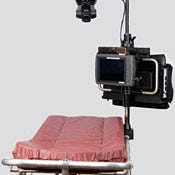Partners in the healthcare delivery system include the FCC, AT&T, the University of California, and more than 800 medical facilities.

| |
| |
Support for telehealth as a viable healthcare delivery model received an enormous boost on Tuesday when Calif. Governor Arnold Schwarzenegger and U.S. chief technology officer Aneesh Chopra joined a diverse group of statewide healthcare and technology agencies to launch the California Telehealth Network (CTN), the largest broadband network dedicated to telehealth in the nation.
The event, held at the University of California, Davis Cancer Center, unveiled a network that will provide specialty care in medically underserved rural and urban areas by connecting more than 800 Calif. clinics and hospitals to a statewide medical-grade network of healthcare and emergency services.
The CTN will integrate wireless and broadband communications technology with medical devices and applications to support technologies like videoconferencing that allow doctors and patients in distant locations to have an in-person-meeting experience. The network will also support telehealth devices such as wireless sensors that remotely monitor heart rhythm and portable glucose monitoring systems.
"California is always leading the way with the most innovative and new technology that is changing the future. And, what we are launching today is a new era for healthcare," Gov. Schwarzenegger said in a statement.
Schwarzenegger described the CTN as a state-of-the-art system that will save lives by instantly connecting people from across the state, including underserved and rural areas, with the best and brightest doctors. "The California Telehealth Network marks the beginning of a new digital highway that will fundamentally change the future of how healthcare is provided," he said.
The CTN is a $30 million joint funding effort between the Federal Communications Commission (FCC), the California Emerging Technology Fund (CETF), the California Healthcare Foundation, UnitedHealthcare, the National Coalition for Healthcare Integration, the University of California, and other private and public entities. It represents the largest single-state grant award of its kind.
The network is also supported by AT&T, which is providing network infrastructure and managed network services for CTN as part of a three-year, $27 million contract that was announced in April.
"There is great need for more accessible acute and specialty care in medically underserved areas across California," U.S. CTO Chopra said in a statement. "With the $22.1 million in grant funding from the FCC, along with $3.6 million in matching funds from the CETF, the CTN will help improve access to quality healthcare in rural and medically underserved areas, over a secure, managed network enabling the delivery of emerging eHealth and telemedicine services."
| |
| |
By using broadband to connect healthcare providers, the CTN will join 68 other networks in the nation and serve as a backbone in establishing telemedicine and eHealthcare.
"With the launch of the California Telehealth Network, we are finally seeing telemedicine start to find viable business models," said Irene Berlinsky, IDC's senior research analyst for multiplay services. "The partnership of government and industry is not only effective, but necessary when the goal is to expand and improve telehealth across an entire state -- let alone one as large as California. Neither industry nor government would be likely to undertake such a project alone."
Berlinsky also observed that by providing the bulk of the investment in CTN, the FCC is showing that it is willing to act on two of its stated goals -- increasing broadband and healthcare access in rural and underserved areas.
"We will increasingly see such public/private partnerships in the future, with medical or government agencies tackling the healthcare logistics, telecommunications providers building out the network that connects facilities, and technology vendors providing the technology piece," Berlinsky said.
Sandra Shewry, president and CEO at the Center for Connected Health Policy, said in a statement that the CTN is a peer-to-peer network which enables providers to share X-rays and other diagnostic tests instantaneously, and view treatments and procedures from distant emergency rooms or surgical centers as they happen
"The CTN also enables the sharing of information for continuing education/distance learning, disaster preparedness, and access to new technologies -- all essential elements for the California healthcare system's growth," Shewry said.
The CTN is being managed and led by the University of California on behalf of the governor's office, with guidance from an advisory board consisting of experts from state government, rural healthcare, telemedicine, and technology. A statewide consortium was initially brought together by the governor's office to develop the CTN project and proposal to the FCC.
"We are eager to see the positive effects over the next few months as we activate the first 50 sites and roll out our eHealth applications that will help transform healthcare delivery in California," Eric Brown, executive director of CTN, said in a statement. "Working with our statewide eHealth partners such as Cal eConnect, CalHIPSO, and HITECH-LA, our vision is to create healthcare delivery infrastructure so that geographic barriers to care are eliminated."
About the Author(s)
You May Also Like










